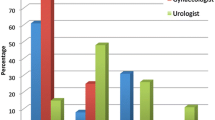Abstract
Teleoperated surgical robots could provide a genuine breakthrough in laparoscopy and it is for this reason that the development of robot-assisted laparoscopy is one of the priorities of the Strasbourg University Hospitals’ strategic plan. The hospitals purchased a da Vinci S® robot in June 2006 and Strasbourg has, in IRCAD, one of the few robotic surgery training centres in the world. Our experience has, however, revealed the difficulties involved in setting up robotic surgery, the first of which are organizational issues. This prospective work was carried out between December 2007 and September 2008, primarily to examine the possibility of setting up robotic surgery on a regular basis for gynaecological surgical procedures at the Strasbourg University Hospitals. We maintained a “logbook” in which we prospectively noted all the resources implemented in setting up the robotic surgery service. The project was divided into two phases: the preparatory phase up until the first hysterectomy and then the second phase with the organization of subsequent hysterectomies. The first surgical procedure took 5 months to organize, and followed 25 interviews, 10 meetings, 53 telephone conversations and 48 e-mails with a total of 40 correspondents. The project was presented to seven separate groups, including the hospital medical commission, the gynaecology unit committee and the surgical staff. Fifteen members of the medical and paramedical team attended a two-day training course. Preparing the gynaecology department for robotic surgery required freeing up 8.5 days of “physician time” and 12.5 days of “nurse time”. In the following five months, we performed five hysterectomies. Preparation for each procedure involved on average 5 interviews, 19 telephone conversations and 11 e-mails. The biggest obstacle was obtaining an operating slot, as on average it required 18 days, four telephone calls and four e-mails to be assigned a slot in the operating theatre schedule, which is prepared on average 28 days in advance. It is extremely important for organising robotic surgery and assembling the surgical teams to have a series of operating slots allocated a sufficiently long time in advance. Considerable benefits would be had by setting up a team of anaesthetists and especially perioperative nurses dedicated to robotic surgery.


Similar content being viewed by others
References
Payne TN, Dauterive FR (2008) A comparison of total laparoscopic hysterectomy to robotically assisted hysterectomy: surgical outcomes in a community practice. J Minim Invasive Gynecol 15(3):286–291
Degueldre M, Vandromme J, Huong PT, Cadière GB (2000) Robotically assisted laparoscopic microsurgical tubal reanastomosis: a feasability study. Fertil Steril 74(5):1020–1023
Advincula AP, Xu X, Goudeau S, Ransom SB (2007) Robot-assisted laparoscopic myomectomy versus abdominal myomectomy: a comparison of short-term surgical outcomes and immediate costs. J Minim Invasive Gynecol 14(6):698–705
Elliott DS, Krambeck AE, Chow GK (2006) Long-term results of robotic assisted laparoscopic sacrocolpopexy for the treatment of high grade vaginal vault prolapse. J Urol 176(2):655–659
Magrina JF, Kho RM, Weaver AL, Montero RP, Magtibay PM (2008) Robotic radical hysterectomy: comparison with laparoscopy and laparotomy. Gynecol Oncol 109(1):86–91
Marescaux J, Leroy J, Gagner M, Rubino F, Mutter D, Vix M, Butner SE, Smith MK (2001) Transatlantic robot-assisted telesurgery. Nature 413(6854):379–380
Pitter MC, Anderson P, Blisset A, Pemberton N (2008) Robotic-assisted gynaecological surgery–establishing training criteria; minimizing operative time and blood loss. Int J Med Robotics Comput Assist Surg 4:114–120
Braumann C, Jacobi CA, Menenakos C, Ismail M, Rueckert JC, Mueller JM (2008) Robotic-assisted laparoscopic and thoracoscopic surgery with the da Vinci system: a 4-year experience in a single institution. Surg Laparosc Endosc Percutan Tech 18(3):260–266
Ali MR, Rasmussen JJ (2008) Switching robotic surgical systems does not impact surgical performance. J Laparoendosc Adv Surg Tech A 18(1):32–36
Author information
Authors and Affiliations
Corresponding author
Rights and permissions
About this article
Cite this article
Sananès, N., Garbin, O., Hummel, M. et al. Setting up robotic surgery in gynaecology: the experience of the Strasbourg teaching hospital. J Robotic Surg 5, 133–136 (2011). https://doi.org/10.1007/s11701-010-0231-x
Received:
Accepted:
Published:
Issue Date:
DOI: https://doi.org/10.1007/s11701-010-0231-x




